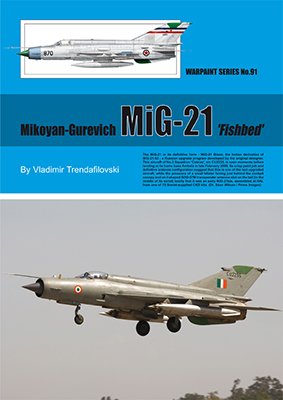
Mikoyan Gurevich MiG-21 'Fishbed'
By Chris Banyai-Riepl
Warpaint Series 91
Author: Vladimir Trendafilovski
Publisher: Warpaint Books
Binding: Softcover
Pages: 124
No matter how you look at it, the MiG-21 is an impressive airplane. Designed early in the Cold War, the MiG-21 entered production in the late 1950s and remains in service today in quite a few countries around the globe. Production just in the Soviet Union totaled over 10,000 aircraft, and when one figures in estimates of Chinese MiG-21 derivatives, that number quickly moves beyond 14,000. With that many built, over that long a time, the number of variants is truly staggering, and trying to keep track of all of them is quite daunting. This latest Warpaint title aims to clear that up, at least for the Soviet examples.
As the author notes, the story of the MiG-21 is extensive and telling it all would easily result in a book ten times the length of this one. So, wisely, the author chose to just focus on variant identification, recognizing that this information would be of great use to the modeler and historian alike. Even with that narrowing of scope (further narrowed by choosing to not cover the Chinese derivatives), the number of variants is still well over 50, so there is a lot of work ahead here.
To keep things as logical as possible, the book follows the development of the MiG-21 chronologically. It begins with coverage of the initial prototypes before going into the first production variants, the MiG-21F family. This is soon followed by the second generation MiG-21 family, the MiG-21P variants, and a short segue into the MiG-21R reconnaissance variant forms the transition between the second generation and third generation MiG-21S (which includes the popular MiG-21M and MF variants). The fourth generation completes the single seater coverage with details on the MiG-21bis, and after that are sections on the two-seaters, experimental, and record-breaking aircraft. Finally, a section on upgrades brings us to the next major break in the book: the MiG-21 in service.
For many, it is this that people find the most fascinating about the MiG-21, as it flew in dozens of countries around the globe in an impressive array of color schemes. As this is a Warpaint title, that means there will be color profiles, and this book does not let down. While the text covers the nations in words, the profiles (and photos) brings those nations into focus, with colorful camouflages and interesting markings all around. There are over 40 illustrations covering MiG-21s, which on the surface seems quite impressive. However, while the book covers an extensive range of variants, the profile illustrations are extremely narrow in scope, with just one M, one SM, and one SMT outside of the MiG-21MF and MiG-21bis coverage. Given the interesting color schemes worn by the first and second generation MiG-21s, not to mention the two-seaters, this limitation is rather disappointing.
Making up for that lack of color artwork, though, are the scale drawings. These are provided on three fold-out pages, printed front and back, and present a single four-view drawing of a MiG-21SM and side drawings of 42 other MiG-21 variants. This is a great way to view the evolution of the design through the different generations, and as such form an excellent complement to the text description of the variants.
Overall, this is a great view on the MiG-21, and its in-depth focus on variant differences will help modelers and aviation historians alike in determining specific MiG-21 types from photos. My thanks to Warpaint Books for the review copy.
